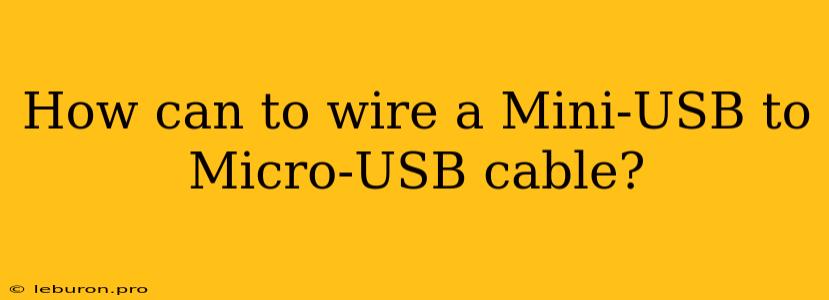How to Wire a Mini-USB to Micro-USB Cable: A Step-by-Step Guide
Connecting devices with different USB port types can be frustrating, especially when you need to transfer data or power between a mini-USB device and a micro-USB one. Thankfully, with a little bit of knowledge and some basic tools, you can easily create your own custom mini-USB to micro-USB cable. This guide will walk you through the process step-by-step, explaining each stage in detail.
Understanding USB Connectors: Mini-USB vs. Micro-USB
Before we dive into the wiring process, it's crucial to understand the differences between mini-USB and micro-USB connectors. Both are commonly used in various electronic devices, but they differ in size and pin configurations.
Mini-USB:
- Size: Larger than a micro-USB connector.
- Pin Configuration: 5 pins (ID, D-, D+, Vcc, GND).
- Applications: Older digital cameras, mobile phones, and some portable devices.
Micro-USB:
- Size: Smaller and more compact than a mini-USB connector.
- Pin Configuration: 5 pins (ID, D-, D+, Vcc, GND).
- Applications: Widely used in Android smartphones, tablets, external hard drives, and various other electronic devices.
Essential Tools and Materials
To successfully wire your mini-USB to micro-USB cable, you'll need the following tools and materials:
- Mini-USB connector: This is the connector that will be plugged into your mini-USB device.
- Micro-USB connector: This is the connector that will be plugged into your micro-USB device.
- USB cable: You can use an old, broken USB cable as a source for the wires.
- Wire strippers: These are essential for stripping the insulation off the wires.
- Soldering iron: Used to securely connect the wires to the connectors.
- Solder: To create a strong connection between the wires and connectors.
- Heat shrink tubing: Used to insulate the soldered joints and protect the wires from damage.
- Multimeter: For testing the continuity of the circuit and ensuring that the wires are correctly connected.
Step-by-Step Wiring Guide
Now, let's proceed with the wiring process. Remember to exercise caution when handling electrical components and soldering tools.
Step 1: Prepare the USB cable
- Carefully cut the USB cable at a point where you can access the wires without damaging the connectors.
- Strip the insulation off the individual wires using wire strippers. You'll need four wires: red (Vcc), black (GND), green (D-), and white (D+).
Step 2: Identify the Pins on the Connectors
- Look closely at the mini-USB and micro-USB connectors. They have markings or a small diagram that indicate the pin positions. You need to match the corresponding pins on both connectors.
- Mini-USB Connector:
- ID: Pin 1 (usually the smaller pin)
- D-: Pin 2
- D+: Pin 3
- Vcc: Pin 4 (usually the larger pin)
- GND: Pin 5
- Micro-USB Connector:
- ID: Pin 1 (usually the smaller pin)
- D-: Pin 2
- D+: Pin 3
- Vcc: Pin 4 (usually the larger pin)
- GND: Pin 5
Step 3: Solder the Wires to the Connectors
- Mini-USB Connector: Carefully solder each wire to its corresponding pin on the mini-USB connector:
- Red wire (Vcc) to pin 4 (Vcc)
- Black wire (GND) to pin 5 (GND)
- Green wire (D-) to pin 2 (D-)
- White wire (D+) to pin 3 (D+)
- Micro-USB Connector: Repeat the same soldering process for the micro-USB connector, ensuring that the wires are connected to their respective pins:
- Red wire (Vcc) to pin 4 (Vcc)
- Black wire (GND) to pin 5 (GND)
- Green wire (D-) to pin 2 (D-)
- White wire (D+) to pin 3 (D+)
Step 4: Insulate the Soldered Joints
- Apply heat shrink tubing over each soldered joint to provide insulation and protect the wires from damage. Use a heat gun or lighter to shrink the tubing tightly around the joints.
Step 5: Test the Continuity of the Circuit
- Use a multimeter to test the continuity between the corresponding pins on the mini-USB and micro-USB connectors.
- Set the multimeter to the "continuity" or "diode" mode.
- Touch the probes to the corresponding pins on each connector, checking that there is a continuous circuit for each wire pair: Vcc to Vcc, GND to GND, D- to D-, and D+ to D+.
Step 6: Assemble the Cable
- Once all the connections have been tested, you can assemble the cable by attaching the mini-USB and micro-USB connectors to the wired ends of the cable.
- Ensure that the connectors are firmly attached and the wires are not strained.
Step 7: Test the Cable
- Finally, test your newly made mini-USB to micro-USB cable by connecting it to a mini-USB device and a micro-USB device.
- Check that data transfers correctly and the device receives power from the cable.
Tips and Precautions
- Use high-quality components: Choose reliable mini-USB and micro-USB connectors for better performance and durability.
- Exercise caution with soldering: Soldering can be dangerous if not done correctly. Always work on a heat-resistant surface and use proper safety gear.
- Double-check the pin connections: Ensure that the wires are soldered to the correct pins on both connectors. Incorrect connections can cause damage to your devices.
- Insulate all exposed wires: To prevent short circuits and ensure safety, make sure all exposed wires are properly insulated.
Conclusion
Creating a mini-USB to micro-USB cable is a relatively straightforward process with the right tools and materials. By following these steps and taking necessary precautions, you can successfully build a custom cable for your specific needs. Remember to always test the cable thoroughly before connecting it to your devices to ensure proper functionality and prevent any potential damage. This custom cable can be a handy solution for connecting older mini-USB devices to newer micro-USB devices, extending the lifespan of your electronics and providing a more versatile way to transfer data and power.
